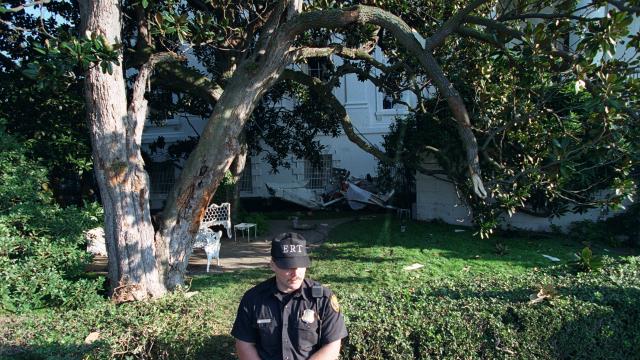Washington D.C. is America’s most protected airspace, shielded by surface-to-air missiles and fighter jets loaded for interception at all hours of the day. But that wasn’t the case on September 12, 1994, when Frank Eugene Corder smashed a stolen Cessna into the president’s front lawn.
The reason I bring this up is because it amazes me how few people have heard about this wild story. A stolen plane loaded with fuel made it through America’s capital, only missing the White House building itself by sheer luck. One of the biggest failures of our nation’s authorities in history happened just three presidents ago, but it’s not very widely known today.
Even more troubling, the Secret Service didn’t see the plane coming. The pilot, allegedly drunk and high, had cut the engine and glided the plane in. Secret Service agents on the lawn didn’t spot it until it had nearly made impact, leaving only seconds for them to get out of the way.
Luckily, the agents did manage to get out of the plane’s path. The plane hit the lawn and slid into the White House, killing Corder but sparing everyone else.
And while this did represent a monumental security failure, the U.S. president wasn’t at much risk due to a lucky coincidence. President Bill Clinton and his wife and daughter were sleeping safely at Blair House across the street, as the White House residence ventilation system was undergoing maintenance.
At the time, the Secret Service argued to the New York Times that the plane making it to the White House didn’t mean they hadn’t handled the situation well:
Security officials said today that the plan for protecting the President against aerial attack relied more on moving him quickly to safety than on stopping the attack.
Secret Service officials, asserting that their shield around the President himself had not been penetrated, said their initial conclusion was that Mr. Corder was not trying to kill the President and appeared to have acted alone, though law-enforcement officials and several agencies would investigate.
Mr. Clinton was awakened at 2:35 A.M. by his chief of staff, Leon E. Panetta, who had been alerted to the 1:49 A.M. crash through a series of calls set in motion by a military aide who was sleeping in the basement of the White House residence, Lieut. Comdr. Richard Fitzpatrick. After being told of the crash, the President went back to sleep, aides said.
It’s hard to imagine that the Secret Service would have been able to whisk the president to safety should he find himself in front of the next plane, as they themselves barely had time to dive out of the Cessna’s path.
And other officials at the Secret Service seemed immediately ready to refute the idea that the agency had a grasp on the situation:
At a White House briefing this afternoon, a Secret Service official painted a picture of frantic activity and jittery uncertainty as the Cessna dropped quietly out of the night sky, landing without flame or fireball.
The official, Carl Meyer, said that agents had spotted the plane only after it completed its U-turn toward the White House and that they only had “enough time to run for cover.”
Mr. Meyer added that he did not know if the Federal Aviation Administration’s radar had detected the Cessna as it approached and violated the capital’s restricted air space, saying that radar could probably not track a small aircraft flying at tree-top level, particularly if it was not using a standard electronic device that identifies the aircraft and enhances its image on radar screens.
By the following day, we knew that the FAA’s radar had in fact picked up Corder’s plane. Information about the rogue flight, though, didn’t make its way to the Secret Service or other defence authorities before Corder had completed his suicide mission.
At the time, the restrictions around D.C. airspace were much laxer than today’s rules. While the Air Defence Identification Zone was put in place at the beginning of the Iraq war and covers most of the D.C. area, flights used to only be restricted from entering the direct vicinity of the National Mall, Capitol and White House. That left U.S. authorities with a much smaller window to intercept rogue aircraft.
Given the intense restrictions put in place since the September 11, 2001 terrorist attacks, it’s safe to assume a plane would have a much harder time getting to the White House today. Not only is the restricted zone much bigger, but the nation’s capital has a slew of anti-aircraft missiles around the city capable of near-instant interception.
That being said, it’s not impenetrable. As a protest, a Florida mailman managed to fly a gyrocopter full of letters to Congresspeople demanding campaign finance reform from Maryland to the Capitol without being detected by NORAD.
Regardless of whether they have the capability to detect and intercept small aeroplanes on suicide missions, it’s hard to say whether they would use it. As the Secret Service claimed in 1994, it probably is easier to get people out of the aeroplane’s path than stop the attack.
While a hole in the White House lawn isn’t great for PR, it’s preferable to lobbing missiles at planes and sending burning wreckage into populated areas.
